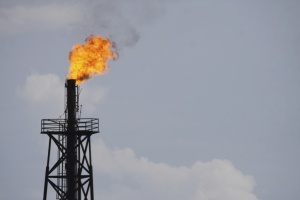Tag Archive for: West Texas Intermediate
“Summer may be a few months away but oil investors are already getting their hopes up that American drivers will do their part to rebalance the market.
Hedge funds increased bets on higher West Texas Intermediate crude prices for the first time in six weeks, shrugging off rising U.S. supplies, as the coming driving season is expected to help ease the glut. Their wagers on more expensive gasoline jumped the most since last year, U.S. Commodity Futures Trading Commission data show.
U.S. fuel producers typically boost crude processing at this time of year as they prepare for the summer surge in demand. In a sign that they’ve already started, a government report showed refineries operating at the highest rate in about three months. Foreign refiners are also developing a taste for American barrels. Crude exports rose to a record in February as China displaced Canada as the biggest customer, Census Bureau data showed.
“As refinery utilization picks up, and if crude exports to Asia remain high, crude supplies will start to deplete,” Thomas Finlon, director of Energy Analytics Group LLC in Wellington, Florida, said by telephone. “The market is focused on where the market is heading, not where it’s been, and crude supplies are going to be whittled down.”
Money managers’ WTI net-long position, or the difference between bets on a price increase and wagers on a drop, climbed 9.2 percent in the week ended April 4 after tumbling 41 percent in the prior five weeks, according to the CFTC. Net bullish bets on gasoline climbed 59 percent, the biggest increase since December.
Refining Boost
Gasoline and diesel producers used 90.8 percent of their crude-processing capacity in the week ended March 31, the most since Jan. 6, according to the Energy Information Administration. Meanwhile, gasoline inventories have fallen almost 8 percent since mid-February, to 239.1 million barrels.
“Bigger-than-expected draws in gasoline stocks help explain the big gain in gasoline net length,” Tim Evans, an energy analyst at Citi Futures Perspective in New York, said by phone. “It probably helped boost interest in WTI.”
Oil futures touched an 18-month high on the first day of trading this year as an accord between the Organization of Petroleum Exporting Countries and 11 other producers to cut output for six months came into effect. Six members of OPEC and Oman back extending production curbs beyond June, with Saudi Arabia and Kuwait saying oil stockpiles need to fall to the five-year average.
The outlook for an extension of the accord has also helped renew optimism that prices will rebound, according to Michael Lynch, president of Strategic Energy & Economic Research in Winchester, Massachusetts.
Bears Retreat
“The oil bears were in retreat because OPEC appears to be complying pretty well to the quota and the likelihood that the cuts will be extended,” Lynch said by phone.
The net-long position in WTI rose by 22,415 futures and options to 267,030. Longs advanced 2.3 percent, while shorts retreated 12 percent. WTI rose 5.5 percent to $51.03 a barrel in the report week. The U.S. benchmark crude was trading at $52.59, up 0.7 percent, at 9:47 a.m. London time on Monday.
Gasoline futures increased 5.3 percent to $1.7217 a gallon in the report period. The May contract was trading at $1.7486 on Monday, extending gains from the highest close for front-month prices since August 2015.
“Gasoline is a safe place to hang your hat as summer approaches,” Energy Analytics’ Finlon said. “Crude supplies will fall as utilization ramps up to meet gasoline demand.”
9 de abril de 2017 18:01 GMT-5

Brent crude futures rose as much as 3 percent on Monday, adding to strong gains last week, on rising hopes that the market has bottomed out and as OPEC kingpin Saudi Arabia said it would work with other producers to limit oil market volatility.
Brent futures were trading at $36.15 per barrel at 11:26 a.m. ET (1626 GMT), up $1.05, or 3 percent. U.S. crude futures traded 98 cents, or 2.7 percent, higher at $33.67 a barrel
Since Feb. 11, the last time Brent was below $30, the crude benchmark has risen by 17 percent, though prices are still a fraction of the $115 of 20 months ago.
“The kingdom (of Saudi Arabia) seeks to achieve stability in the oil markets and will always remain in contact with all main producers in an attempt to limit volatility and it welcomes any cooperative action,” the Saudi cabinet said in a statement.
Saudi Arabia and several fellow OPEC members agreed with non-OPEC Russia this month to freeze output at January levels in an attempt to prop up prices.
Russian President Vladimir Putin called a meeting with top managers of his country’s leading oil producers on Tuesday.
However, Iran remains the main obstacle to a global output freeze because it is determined to ramp up supply after the country’s emergence from international economic sanctions in January.
On Monday Iran said it had increased exports steeply over the past month. Exports climbed as high as 1.75 million barrels per day, adding to an already oversupplied market.
“There is still a lot of downside risk … but the U.S. crude market seems to have passed the worst point and crude runs should start creeping higher, taking pressure off inventory levels,” said Richard Gorry, director of JBC Energy Asia.
U.S. producers cut the number of rigs drilling for oil for a tenth week running, taking the rig count to its lowest since December 2009.
A Reuters monthly poll showed on Monday that oil prices are expected to average a little more than $40 a barrel this year.

Copyright: CNBC
Scroll to top


